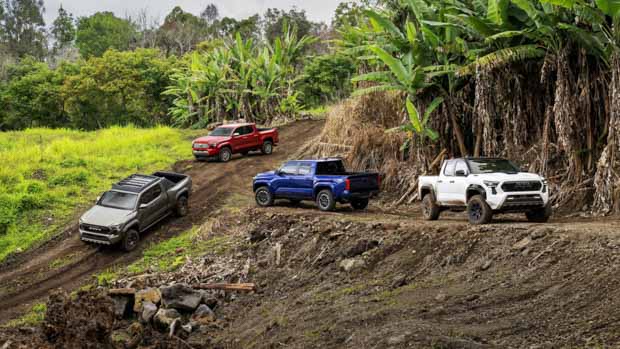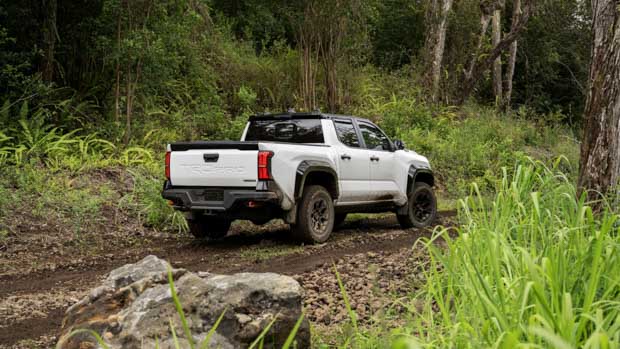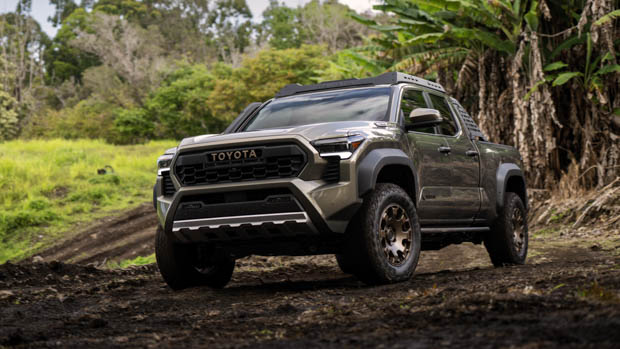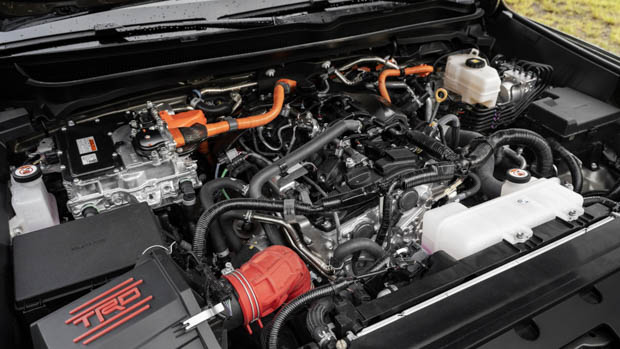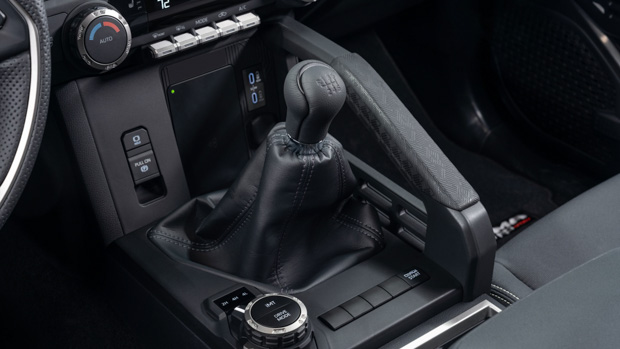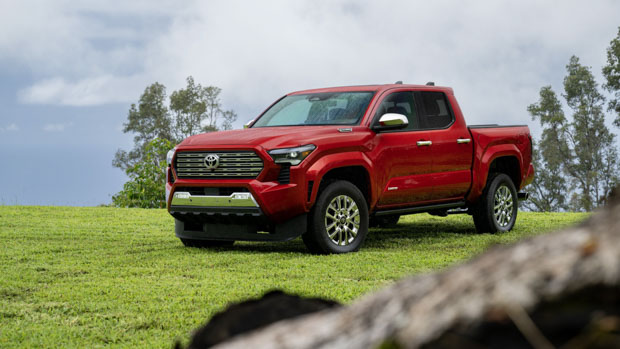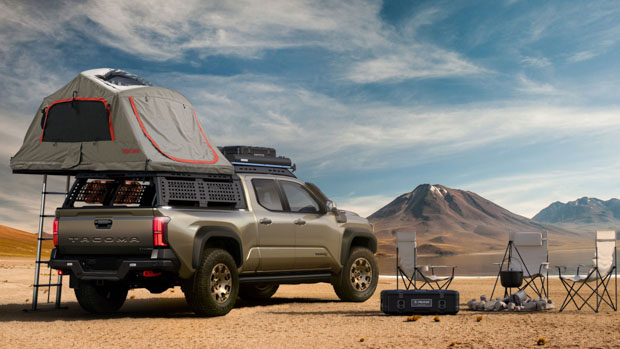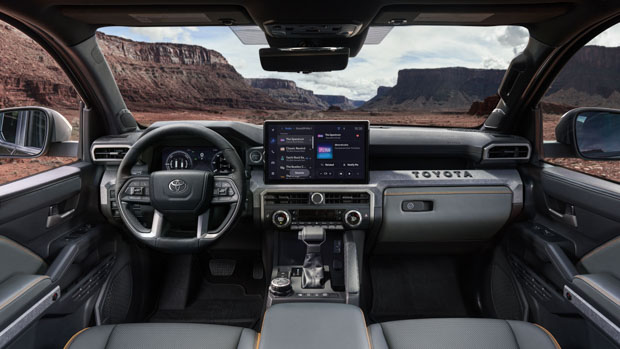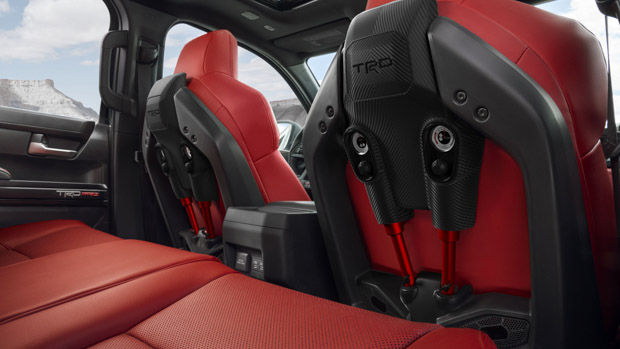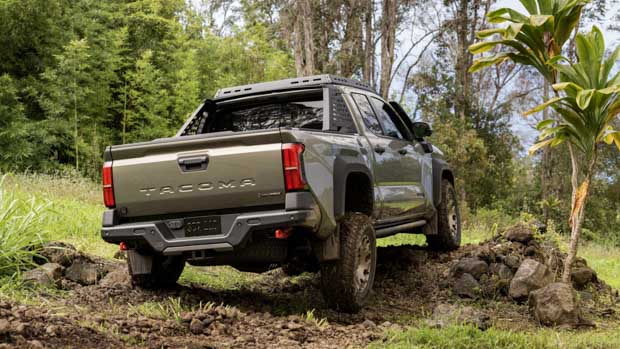-
Car Reviews
- Car News
-
Car Comparisons
Latest comparisons
- Chasing Deals
Hybrid power, a manual transmission option, and Australian-made parts feature on Toyota’s next-generation Tacoma ute
Toyota has finally unveiled the much-anticipated fourth-generation Tacoma, the US cousin to the Hilux, which is set to go on sale in North America later this year.
As well as confirming the new Tacoma, Toyota also revealed that the ute will benefit from hybrid power when it launches with the I-Force Max system in 2024.
Described as a “ground up” redesign, the new Tacoma is based on Toyota’s body-on-frame TNGA-F global truck platform shared with the larger Tundra confirmed for future Australian release.
Significant advancement has gone into Tacoma’s underpinnings. It features a coil sprung multilink rear suspension in higher-spec grades, replacing the outgoing left-sprung design. Another first is that adaptive suspension is offered in range.
The new Tacoma’s edgy brutish production styling is faithful to teaser images published in the past and marks a strong departure from its rounder forebear. It’s been styled by the same Calty Design Center that also penned the current Tundra and Sequoia models.
Body wise, a new, stretched XtraCab long-bed configuration will be available for a range that has traditionally offered two bed sizes in its single-cab variants.
Once on sale, it’s likely that this new Tacoma will face competition from its traditional rivals in the Ford Ranger, Chevrolet Colorado, and the Nissan Frontier.
The huge advancement leap of this new generation of Tacoma pick-up certainly bodes well for the next-gen Hilux, particularly if the latter incorporates similar high-output hybrid powertrain options, the same global TNGA-F platform, and various other componentry.
Turbocharging has arrived in Tacoma, which has persevered to date with aging naturally aspirated V6 power in its outgoing third generation.
At launch, the Tacoma will be offered with a 2.4-litre four-cylinder turbo-petrol engine in two states of tune.
In the entry-level model, this engine will produce 170kW and 329Nm. In all other grades, these figures jump to 214kW and 429Nm when paired with the eight-speed automatic transmission.
Things are slightly different when this engine is paired with the optional six-speed manual transmission, where the engine produces slightly more modest 201kW/420NM outputs.
As mentioned, Toyota will also bring the I-Force Max hybrid system to the Tacoma at a later date.
This system pairs the same 2.4-litre turbo-petrol engine with a single 35kW electric motor that’s integrated into the eight-speed automatic transmission. This system also makes use of a 1.87kWh battery.
With the I-Force Max hybrid system, peak outputs of the Tacoma are increased to 243kW and 630Nm of torque. That’s certainly approaching the level of performance offered by key rival Ford Ranger Raptor, with 292kW and 583Nm from its biturbo petrol V6.
As for towing, the Tacoma range is rated to a maximum braked limit of 2948kg, which is down on the 3.5-tonne standard offered by dual-cab utes in Australia. And as for payload, the Tacoma is rated to 775kg.
Other powertrain goodies include a limited-slip differential in both rear-wheel and four-wheel drive variants, with the latter also getting a two-speed transfer case as standard.
It’s also worth noting that an adaptive damper suspension system is available on the Limited grade. As is tradition, a selection of TRD, Bilstein, (Australian) ARB and Fox-branded off-road suspension tweaks are offered as standard fitment on specific trim grades.
As a high-spec off-road variant, the Tacoma Trailhunter is designed to be an out-of-the-box overlanding rig.
Not only does it sit on ARB’s Old Man Emu suspension, but the recovery points, the rear steel bumper, and the bed utility bar were co-developed with the Australian off-road outfit.
The Trailhuner also gets 33-inch all-terrain tyres, a snorkel, rock rails, an LED light bar, and steel skid plates to boost its off-road prowess.
Toyota also notes that the 2400W AC inverter provides power to both the cabin and the bed, which can be used to power devices such as a fridge.
On the inside, it’s clear that Toyota is aiming for a rugged aesthetic, with tough materials used throughout the cabin.
Buyers will have the option to choose between an 8.0-inch or 14.0-inch infotainment screen, with both running a system that supports wireless Apple Carplay and Android Auto.
Along the same lines, a 7.0-inch digital cluster is standard in lower grade variants, whereas high-spec models get a 12.3-inch screen behind the steering wheel.
Other features include a wireless phone charger, and a pair of USB-C charging ports.
Arguably the most interesting feature of the Tacoma’s cabin are the “IsoDynamic” seats that are included with the PreRunner grade.
These seats use an air-over-oil shock absorber system that works to stabilize the front seats, to “improve focus, comfort, and reduce fatigue while on rugged trails.”
Another interesting feature is the optional JBL speaker system that comes with a portable speaker that can be removed from its cradle on the dash.
This bluetooth speaker can run for up to six hours, and survive being submerged in up to 90 centimetres of water.
Toyota also noted that its Safety Sense 3.0 system is standard across all grades of Tacoma, which adds a plethora of active features.
This system includes AEB, lane-keep assist, adaptive cruise control, road sign recognition, and proactive driving assist among others.
Latest news
About Chasing cars
Chasing Cars reviews are 100% independent.
Because we are powered by Budget Direct Insurance, we don’t receive advertising or sales revenue from car manufacturers.
We’re truly independent – giving you Australia’s best car reviews.
